Holmes Institute HI6025: Critical Review of Lease Accounting
VerifiedAdded on 2023/03/17
|17
|4604
|65
Report
AI Summary
This report provides a comprehensive critical review of the Australian Accounting Standard 16 (AASB 16) for lease accounting. It begins with an introduction to leasing and the role of AASB 16 in Australia, explaining the shift from the older accounting standard. The report evaluates the drawbacks of the old standard, highlighting the need for change, and details the changes incorporated in the new standard, including the recognition of right-of-use assets and lease liabilities. It then analyzes the impact of AASB 16 on companies with significant leasing activities, such as retailers and airlines, and explores why companies previously classified most leases as operating leases. The report discusses how AASB 16 aims to improve comparability, potentially influencing companies' decisions to buy or lease assets. It also covers key disclosures required by companies under the new standard. The report concludes with a summary of the key findings and a list of references.
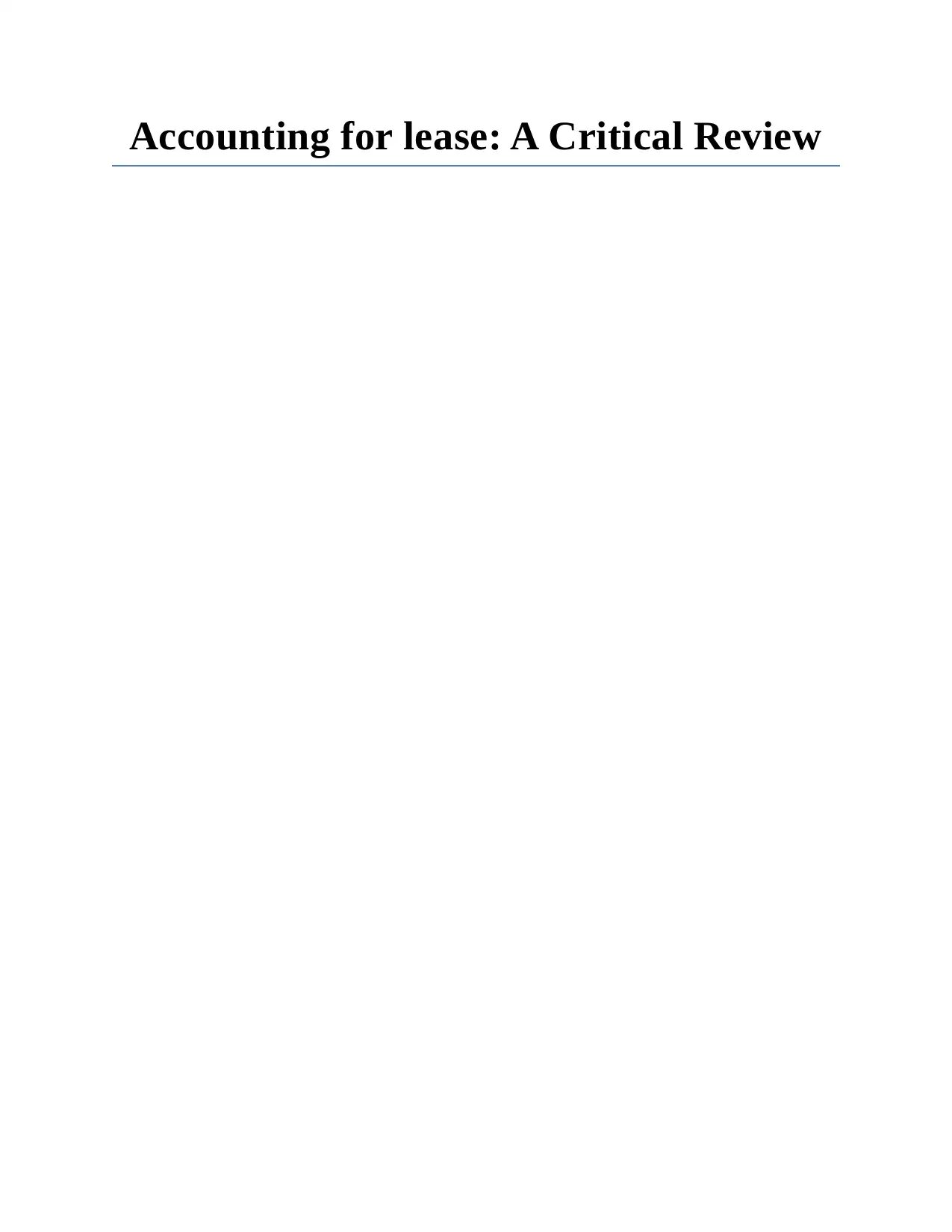
Accounting for lease: A Critical Review
Paraphrase This Document
Need a fresh take? Get an instant paraphrase of this document with our AI Paraphraser
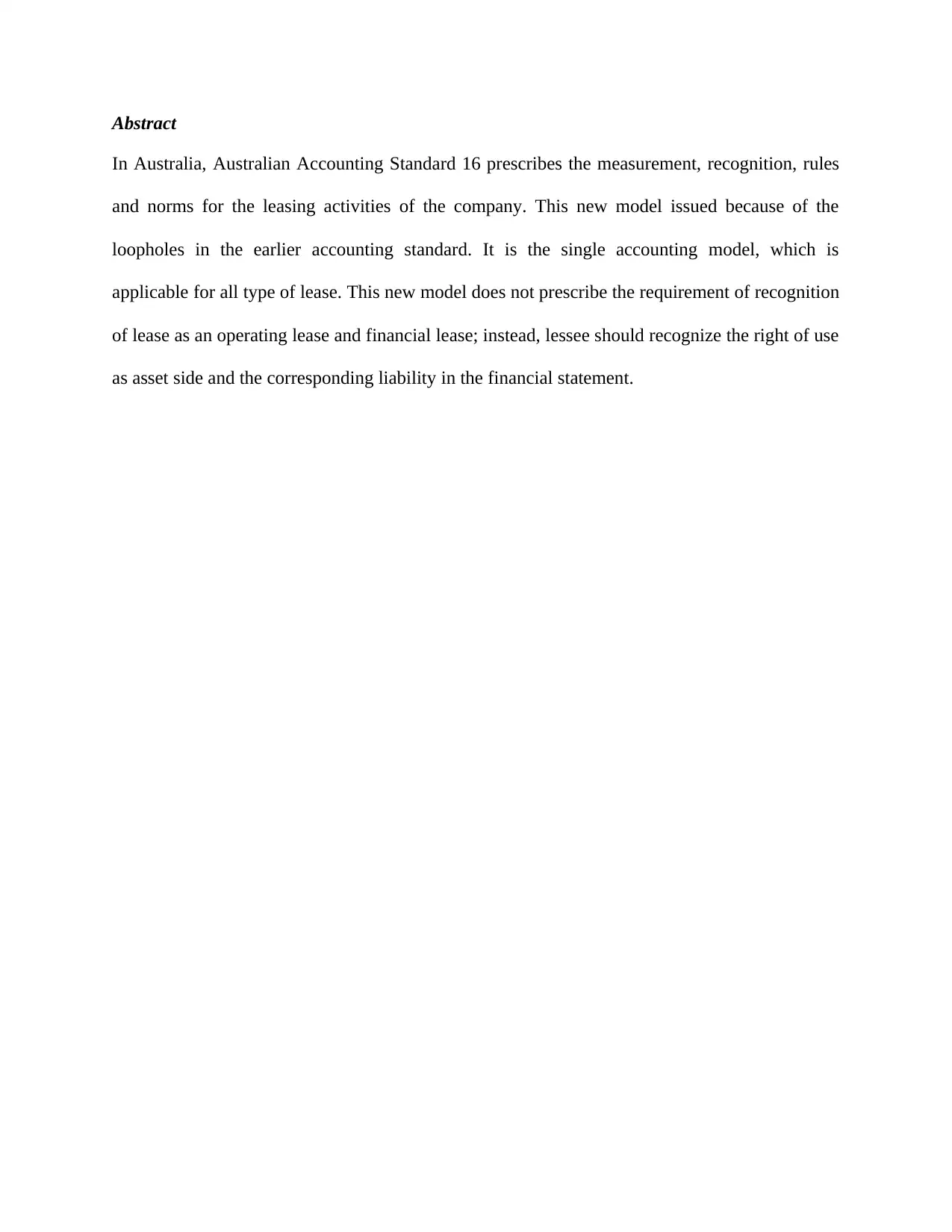
Abstract
In Australia, Australian Accounting Standard 16 prescribes the measurement, recognition, rules
and norms for the leasing activities of the company. This new model issued because of the
loopholes in the earlier accounting standard. It is the single accounting model, which is
applicable for all type of lease. This new model does not prescribe the requirement of recognition
of lease as an operating lease and financial lease; instead, lessee should recognize the right of use
as asset side and the corresponding liability in the financial statement.
In Australia, Australian Accounting Standard 16 prescribes the measurement, recognition, rules
and norms for the leasing activities of the company. This new model issued because of the
loopholes in the earlier accounting standard. It is the single accounting model, which is
applicable for all type of lease. This new model does not prescribe the requirement of recognition
of lease as an operating lease and financial lease; instead, lessee should recognize the right of use
as asset side and the corresponding liability in the financial statement.
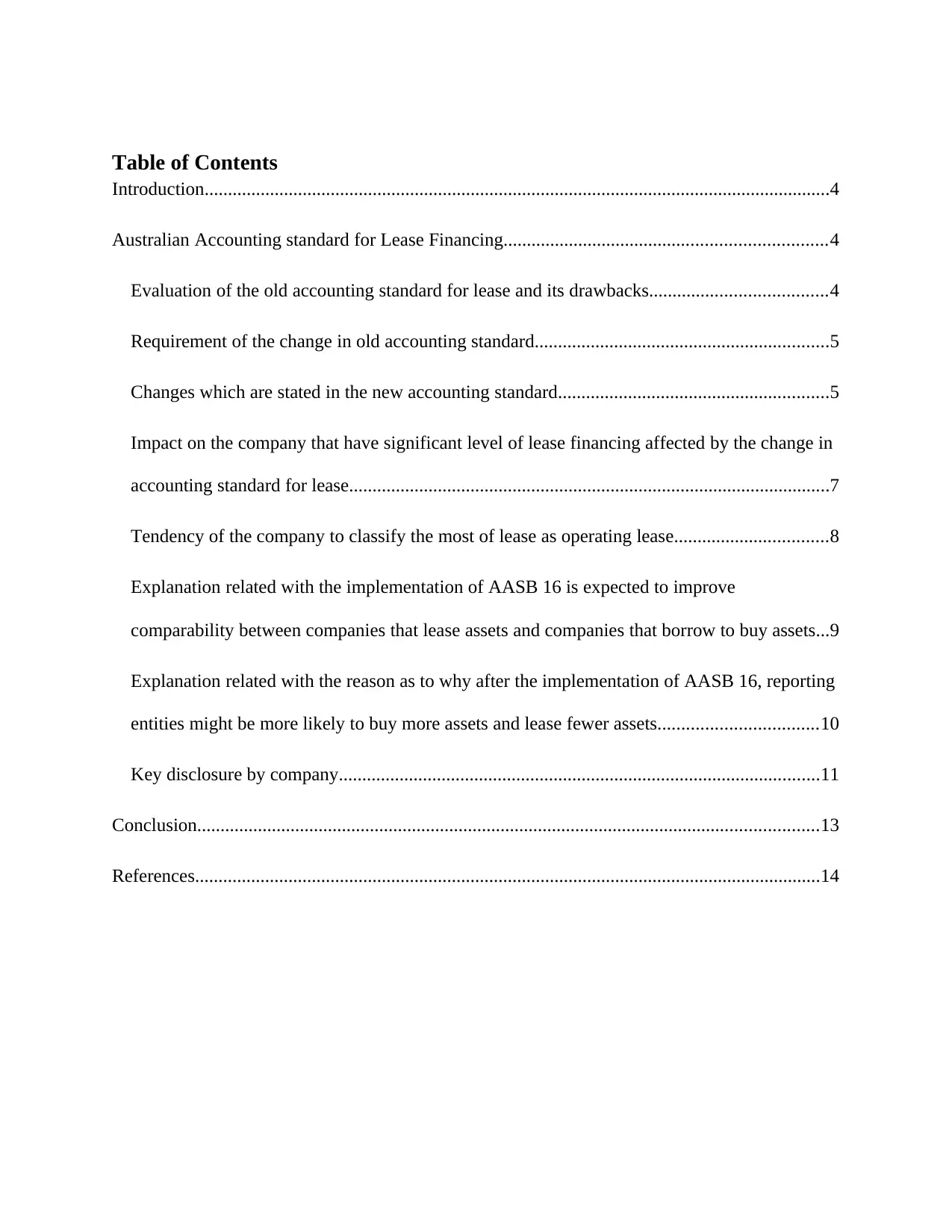
Table of Contents
Introduction......................................................................................................................................4
Australian Accounting standard for Lease Financing.....................................................................4
Evaluation of the old accounting standard for lease and its drawbacks......................................4
Requirement of the change in old accounting standard...............................................................5
Changes which are stated in the new accounting standard..........................................................5
Impact on the company that have significant level of lease financing affected by the change in
accounting standard for lease.......................................................................................................7
Tendency of the company to classify the most of lease as operating lease.................................8
Explanation related with the implementation of AASB 16 is expected to improve
comparability between companies that lease assets and companies that borrow to buy assets...9
Explanation related with the reason as to why after the implementation of AASB 16, reporting
entities might be more likely to buy more assets and lease fewer assets..................................10
Key disclosure by company.......................................................................................................11
Conclusion.....................................................................................................................................13
References......................................................................................................................................14
Introduction......................................................................................................................................4
Australian Accounting standard for Lease Financing.....................................................................4
Evaluation of the old accounting standard for lease and its drawbacks......................................4
Requirement of the change in old accounting standard...............................................................5
Changes which are stated in the new accounting standard..........................................................5
Impact on the company that have significant level of lease financing affected by the change in
accounting standard for lease.......................................................................................................7
Tendency of the company to classify the most of lease as operating lease.................................8
Explanation related with the implementation of AASB 16 is expected to improve
comparability between companies that lease assets and companies that borrow to buy assets...9
Explanation related with the reason as to why after the implementation of AASB 16, reporting
entities might be more likely to buy more assets and lease fewer assets..................................10
Key disclosure by company.......................................................................................................11
Conclusion.....................................................................................................................................13
References......................................................................................................................................14
⊘ This is a preview!⊘
Do you want full access?
Subscribe today to unlock all pages.

Trusted by 1+ million students worldwide
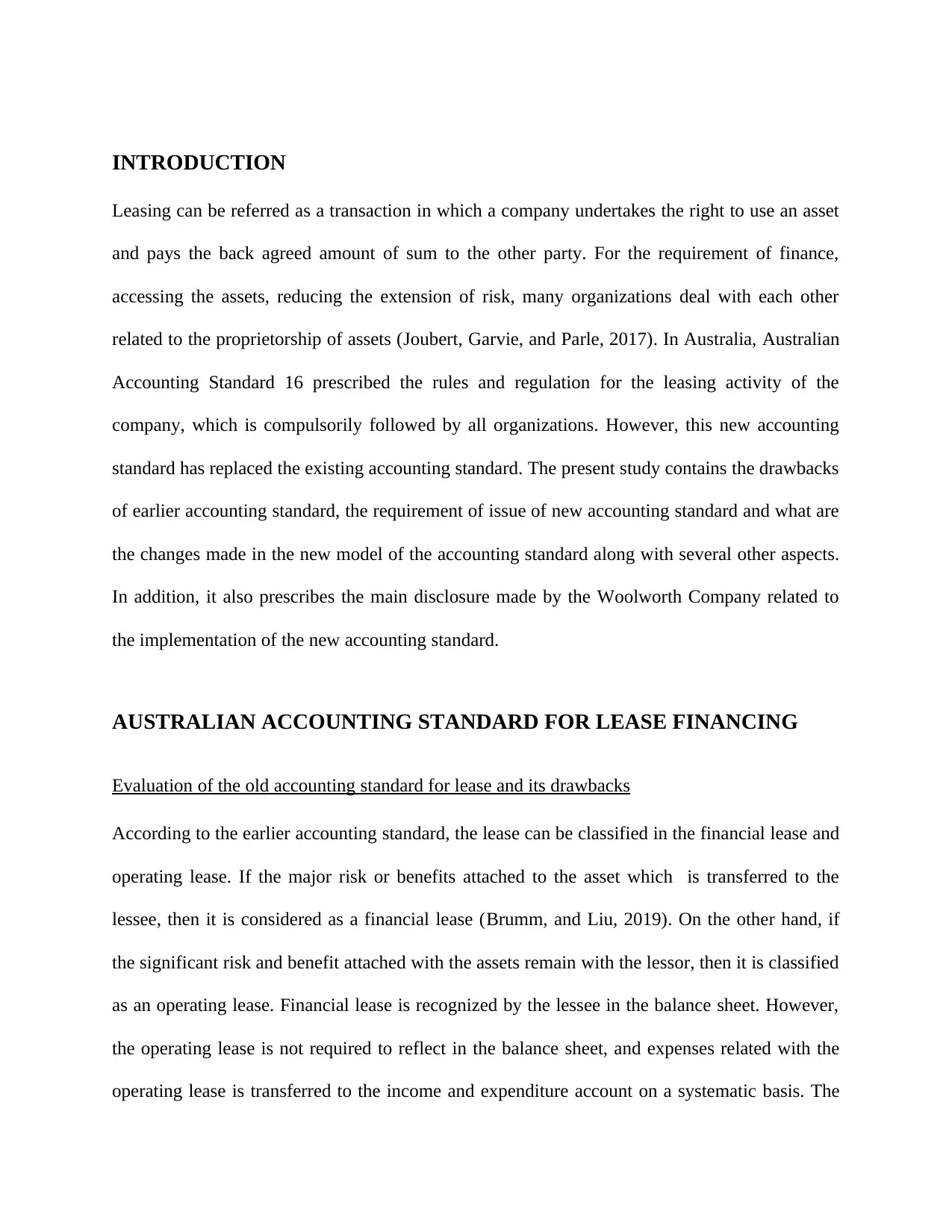
INTRODUCTION
Leasing can be referred as a transaction in which a company undertakes the right to use an asset
and pays the back agreed amount of sum to the other party. For the requirement of finance,
accessing the assets, reducing the extension of risk, many organizations deal with each other
related to the proprietorship of assets (Joubert, Garvie, and Parle, 2017). In Australia, Australian
Accounting Standard 16 prescribed the rules and regulation for the leasing activity of the
company, which is compulsorily followed by all organizations. However, this new accounting
standard has replaced the existing accounting standard. The present study contains the drawbacks
of earlier accounting standard, the requirement of issue of new accounting standard and what are
the changes made in the new model of the accounting standard along with several other aspects.
In addition, it also prescribes the main disclosure made by the Woolworth Company related to
the implementation of the new accounting standard.
AUSTRALIAN ACCOUNTING STANDARD FOR LEASE FINANCING
Evaluation of the old accounting standard for lease and its drawbacks
According to the earlier accounting standard, the lease can be classified in the financial lease and
operating lease. If the major risk or benefits attached to the asset which is transferred to the
lessee, then it is considered as a financial lease (Brumm, and Liu, 2019). On the other hand, if
the significant risk and benefit attached with the assets remain with the lessor, then it is classified
as an operating lease. Financial lease is recognized by the lessee in the balance sheet. However,
the operating lease is not required to reflect in the balance sheet, and expenses related with the
operating lease is transferred to the income and expenditure account on a systematic basis. The
Leasing can be referred as a transaction in which a company undertakes the right to use an asset
and pays the back agreed amount of sum to the other party. For the requirement of finance,
accessing the assets, reducing the extension of risk, many organizations deal with each other
related to the proprietorship of assets (Joubert, Garvie, and Parle, 2017). In Australia, Australian
Accounting Standard 16 prescribed the rules and regulation for the leasing activity of the
company, which is compulsorily followed by all organizations. However, this new accounting
standard has replaced the existing accounting standard. The present study contains the drawbacks
of earlier accounting standard, the requirement of issue of new accounting standard and what are
the changes made in the new model of the accounting standard along with several other aspects.
In addition, it also prescribes the main disclosure made by the Woolworth Company related to
the implementation of the new accounting standard.
AUSTRALIAN ACCOUNTING STANDARD FOR LEASE FINANCING
Evaluation of the old accounting standard for lease and its drawbacks
According to the earlier accounting standard, the lease can be classified in the financial lease and
operating lease. If the major risk or benefits attached to the asset which is transferred to the
lessee, then it is considered as a financial lease (Brumm, and Liu, 2019). On the other hand, if
the significant risk and benefit attached with the assets remain with the lessor, then it is classified
as an operating lease. Financial lease is recognized by the lessee in the balance sheet. However,
the operating lease is not required to reflect in the balance sheet, and expenses related with the
operating lease is transferred to the income and expenditure account on a systematic basis. The
Paraphrase This Document
Need a fresh take? Get an instant paraphrase of this document with our AI Paraphraser
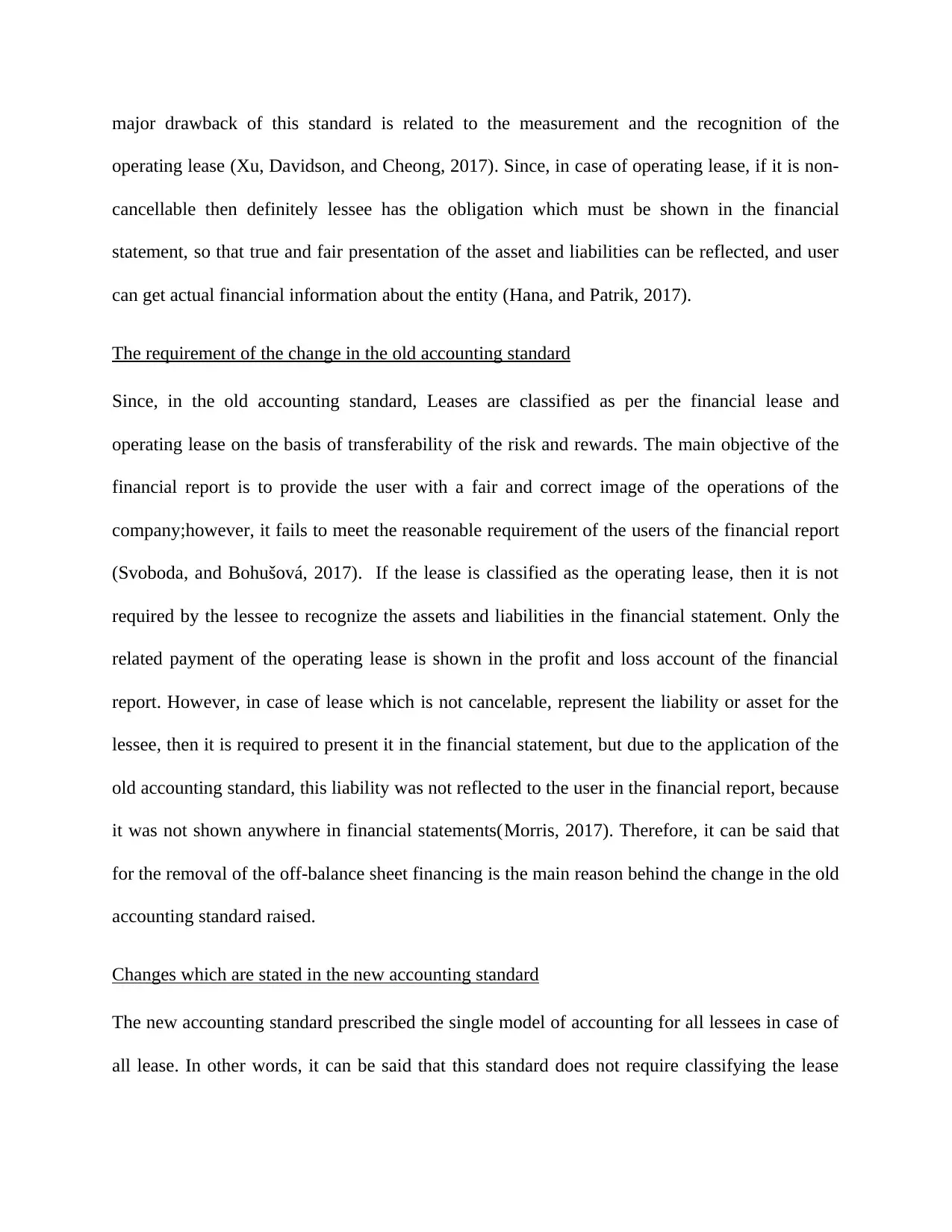
major drawback of this standard is related to the measurement and the recognition of the
operating lease (Xu, Davidson, and Cheong, 2017). Since, in case of operating lease, if it is non-
cancellable then definitely lessee has the obligation which must be shown in the financial
statement, so that true and fair presentation of the asset and liabilities can be reflected, and user
can get actual financial information about the entity (Hana, and Patrik, 2017).
The requirement of the change in the old accounting standard
Since, in the old accounting standard, Leases are classified as per the financial lease and
operating lease on the basis of transferability of the risk and rewards. The main objective of the
financial report is to provide the user with a fair and correct image of the operations of the
company;however, it fails to meet the reasonable requirement of the users of the financial report
(Svoboda, and Bohušová, 2017). If the lease is classified as the operating lease, then it is not
required by the lessee to recognize the assets and liabilities in the financial statement. Only the
related payment of the operating lease is shown in the profit and loss account of the financial
report. However, in case of lease which is not cancelable, represent the liability or asset for the
lessee, then it is required to present it in the financial statement, but due to the application of the
old accounting standard, this liability was not reflected to the user in the financial report, because
it was not shown anywhere in financial statements(Morris, 2017). Therefore, it can be said that
for the removal of the off-balance sheet financing is the main reason behind the change in the old
accounting standard raised.
Changes which are stated in the new accounting standard
The new accounting standard prescribed the single model of accounting for all lessees in case of
all lease. In other words, it can be said that this standard does not require classifying the lease
operating lease (Xu, Davidson, and Cheong, 2017). Since, in case of operating lease, if it is non-
cancellable then definitely lessee has the obligation which must be shown in the financial
statement, so that true and fair presentation of the asset and liabilities can be reflected, and user
can get actual financial information about the entity (Hana, and Patrik, 2017).
The requirement of the change in the old accounting standard
Since, in the old accounting standard, Leases are classified as per the financial lease and
operating lease on the basis of transferability of the risk and rewards. The main objective of the
financial report is to provide the user with a fair and correct image of the operations of the
company;however, it fails to meet the reasonable requirement of the users of the financial report
(Svoboda, and Bohušová, 2017). If the lease is classified as the operating lease, then it is not
required by the lessee to recognize the assets and liabilities in the financial statement. Only the
related payment of the operating lease is shown in the profit and loss account of the financial
report. However, in case of lease which is not cancelable, represent the liability or asset for the
lessee, then it is required to present it in the financial statement, but due to the application of the
old accounting standard, this liability was not reflected to the user in the financial report, because
it was not shown anywhere in financial statements(Morris, 2017). Therefore, it can be said that
for the removal of the off-balance sheet financing is the main reason behind the change in the old
accounting standard raised.
Changes which are stated in the new accounting standard
The new accounting standard prescribed the single model of accounting for all lessees in case of
all lease. In other words, it can be said that this standard does not require classifying the lease
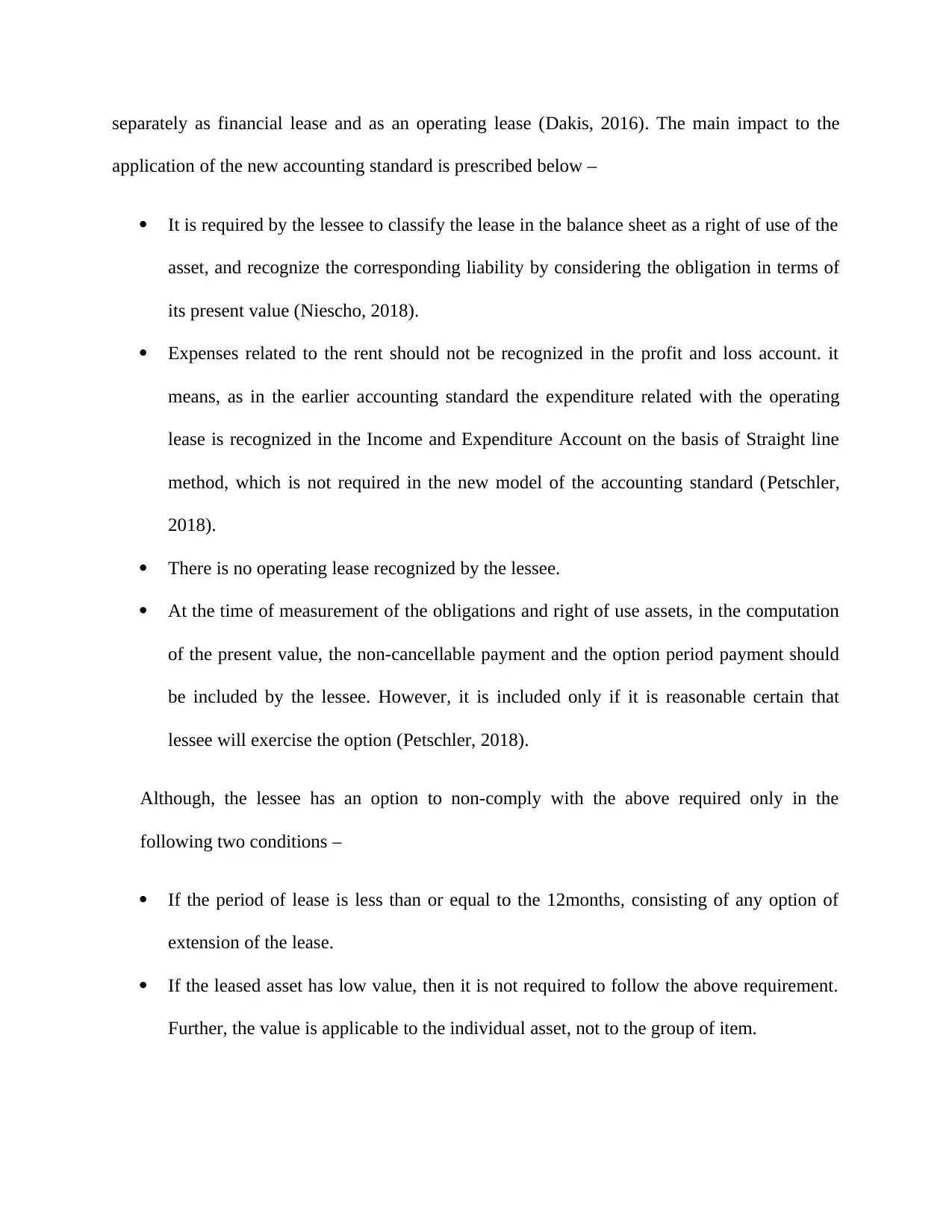
separately as financial lease and as an operating lease (Dakis, 2016). The main impact to the
application of the new accounting standard is prescribed below –
It is required by the lessee to classify the lease in the balance sheet as a right of use of the
asset, and recognize the corresponding liability by considering the obligation in terms of
its present value (Niescho, 2018).
Expenses related to the rent should not be recognized in the profit and loss account. it
means, as in the earlier accounting standard the expenditure related with the operating
lease is recognized in the Income and Expenditure Account on the basis of Straight line
method, which is not required in the new model of the accounting standard (Petschler,
2018).
There is no operating lease recognized by the lessee.
At the time of measurement of the obligations and right of use assets, in the computation
of the present value, the non-cancellable payment and the option period payment should
be included by the lessee. However, it is included only if it is reasonable certain that
lessee will exercise the option (Petschler, 2018).
Although, the lessee has an option to non-comply with the above required only in the
following two conditions –
If the period of lease is less than or equal to the 12months, consisting of any option of
extension of the lease.
If the leased asset has low value, then it is not required to follow the above requirement.
Further, the value is applicable to the individual asset, not to the group of item.
application of the new accounting standard is prescribed below –
It is required by the lessee to classify the lease in the balance sheet as a right of use of the
asset, and recognize the corresponding liability by considering the obligation in terms of
its present value (Niescho, 2018).
Expenses related to the rent should not be recognized in the profit and loss account. it
means, as in the earlier accounting standard the expenditure related with the operating
lease is recognized in the Income and Expenditure Account on the basis of Straight line
method, which is not required in the new model of the accounting standard (Petschler,
2018).
There is no operating lease recognized by the lessee.
At the time of measurement of the obligations and right of use assets, in the computation
of the present value, the non-cancellable payment and the option period payment should
be included by the lessee. However, it is included only if it is reasonable certain that
lessee will exercise the option (Petschler, 2018).
Although, the lessee has an option to non-comply with the above required only in the
following two conditions –
If the period of lease is less than or equal to the 12months, consisting of any option of
extension of the lease.
If the leased asset has low value, then it is not required to follow the above requirement.
Further, the value is applicable to the individual asset, not to the group of item.
⊘ This is a preview!⊘
Do you want full access?
Subscribe today to unlock all pages.

Trusted by 1+ million students worldwide
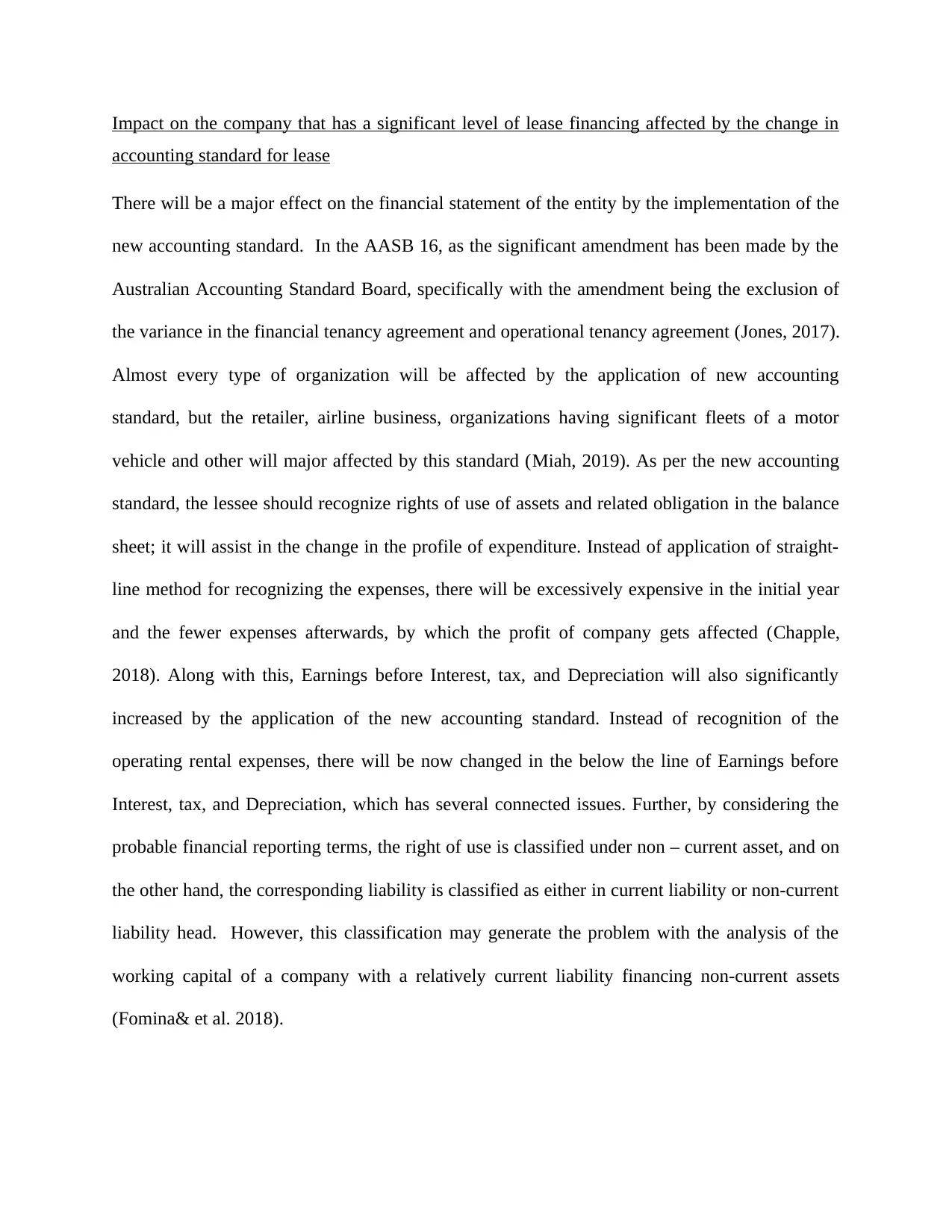
Impact on the company that has a significant level of lease financing affected by the change in
accounting standard for lease
There will be a major effect on the financial statement of the entity by the implementation of the
new accounting standard. In the AASB 16, as the significant amendment has been made by the
Australian Accounting Standard Board, specifically with the amendment being the exclusion of
the variance in the financial tenancy agreement and operational tenancy agreement (Jones, 2017).
Almost every type of organization will be affected by the application of new accounting
standard, but the retailer, airline business, organizations having significant fleets of a motor
vehicle and other will major affected by this standard (Miah, 2019). As per the new accounting
standard, the lessee should recognize rights of use of assets and related obligation in the balance
sheet; it will assist in the change in the profile of expenditure. Instead of application of straight-
line method for recognizing the expenses, there will be excessively expensive in the initial year
and the fewer expenses afterwards, by which the profit of company gets affected (Chapple,
2018). Along with this, Earnings before Interest, tax, and Depreciation will also significantly
increased by the application of the new accounting standard. Instead of recognition of the
operating rental expenses, there will be now changed in the below the line of Earnings before
Interest, tax, and Depreciation, which has several connected issues. Further, by considering the
probable financial reporting terms, the right of use is classified under non – current asset, and on
the other hand, the corresponding liability is classified as either in current liability or non-current
liability head. However, this classification may generate the problem with the analysis of the
working capital of a company with a relatively current liability financing non-current assets
(Fomina& et al. 2018).
accounting standard for lease
There will be a major effect on the financial statement of the entity by the implementation of the
new accounting standard. In the AASB 16, as the significant amendment has been made by the
Australian Accounting Standard Board, specifically with the amendment being the exclusion of
the variance in the financial tenancy agreement and operational tenancy agreement (Jones, 2017).
Almost every type of organization will be affected by the application of new accounting
standard, but the retailer, airline business, organizations having significant fleets of a motor
vehicle and other will major affected by this standard (Miah, 2019). As per the new accounting
standard, the lessee should recognize rights of use of assets and related obligation in the balance
sheet; it will assist in the change in the profile of expenditure. Instead of application of straight-
line method for recognizing the expenses, there will be excessively expensive in the initial year
and the fewer expenses afterwards, by which the profit of company gets affected (Chapple,
2018). Along with this, Earnings before Interest, tax, and Depreciation will also significantly
increased by the application of the new accounting standard. Instead of recognition of the
operating rental expenses, there will be now changed in the below the line of Earnings before
Interest, tax, and Depreciation, which has several connected issues. Further, by considering the
probable financial reporting terms, the right of use is classified under non – current asset, and on
the other hand, the corresponding liability is classified as either in current liability or non-current
liability head. However, this classification may generate the problem with the analysis of the
working capital of a company with a relatively current liability financing non-current assets
(Fomina& et al. 2018).
Paraphrase This Document
Need a fresh take? Get an instant paraphrase of this document with our AI Paraphraser
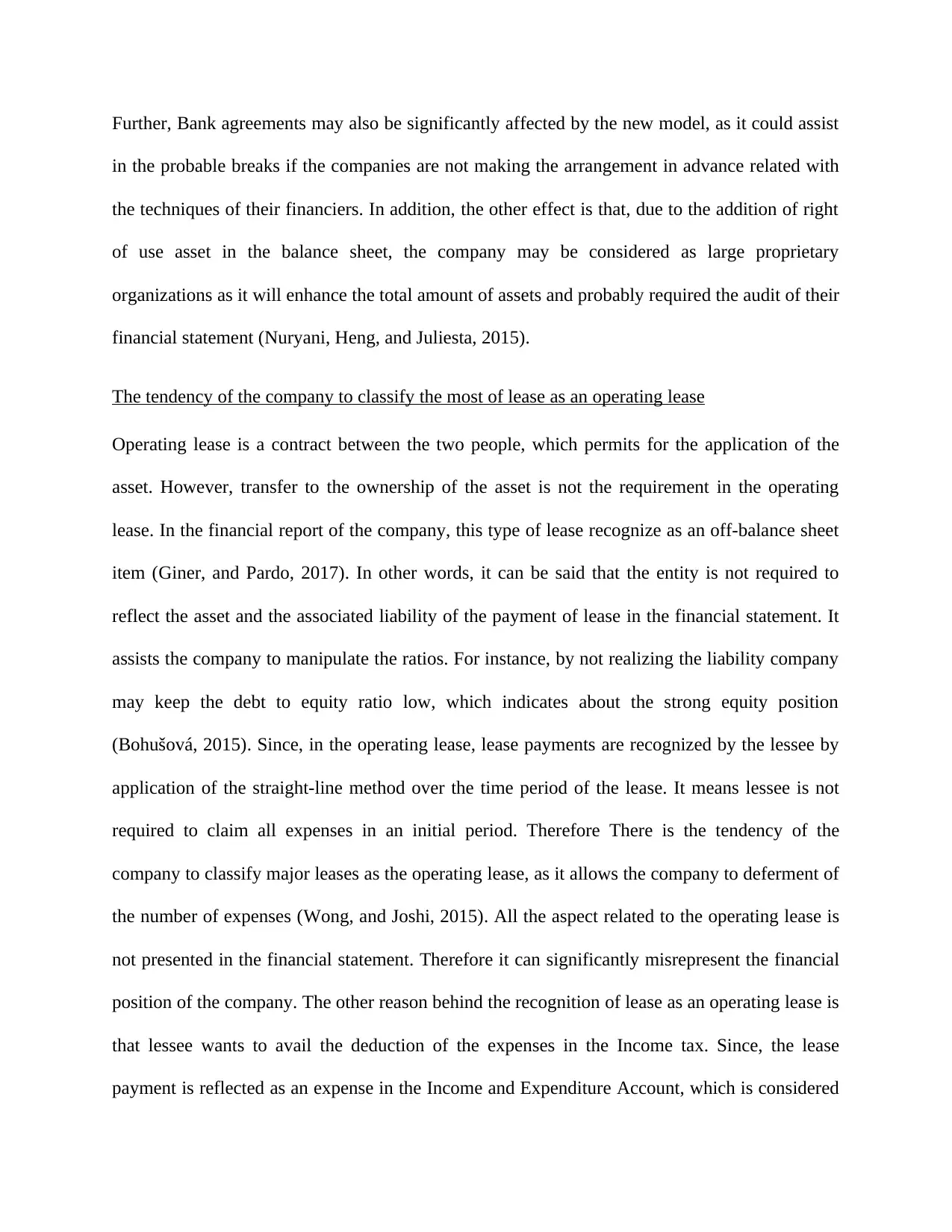
Further, Bank agreements may also be significantly affected by the new model, as it could assist
in the probable breaks if the companies are not making the arrangement in advance related with
the techniques of their financiers. In addition, the other effect is that, due to the addition of right
of use asset in the balance sheet, the company may be considered as large proprietary
organizations as it will enhance the total amount of assets and probably required the audit of their
financial statement (Nuryani, Heng, and Juliesta, 2015).
The tendency of the company to classify the most of lease as an operating lease
Operating lease is a contract between the two people, which permits for the application of the
asset. However, transfer to the ownership of the asset is not the requirement in the operating
lease. In the financial report of the company, this type of lease recognize as an off-balance sheet
item (Giner, and Pardo, 2017). In other words, it can be said that the entity is not required to
reflect the asset and the associated liability of the payment of lease in the financial statement. It
assists the company to manipulate the ratios. For instance, by not realizing the liability company
may keep the debt to equity ratio low, which indicates about the strong equity position
(Bohušová, 2015). Since, in the operating lease, lease payments are recognized by the lessee by
application of the straight-line method over the time period of the lease. It means lessee is not
required to claim all expenses in an initial period. Therefore There is the tendency of the
company to classify major leases as the operating lease, as it allows the company to deferment of
the number of expenses (Wong, and Joshi, 2015). All the aspect related to the operating lease is
not presented in the financial statement. Therefore it can significantly misrepresent the financial
position of the company. The other reason behind the recognition of lease as an operating lease is
that lessee wants to avail the deduction of the expenses in the Income tax. Since, the lease
payment is reflected as an expense in the Income and Expenditure Account, which is considered
in the probable breaks if the companies are not making the arrangement in advance related with
the techniques of their financiers. In addition, the other effect is that, due to the addition of right
of use asset in the balance sheet, the company may be considered as large proprietary
organizations as it will enhance the total amount of assets and probably required the audit of their
financial statement (Nuryani, Heng, and Juliesta, 2015).
The tendency of the company to classify the most of lease as an operating lease
Operating lease is a contract between the two people, which permits for the application of the
asset. However, transfer to the ownership of the asset is not the requirement in the operating
lease. In the financial report of the company, this type of lease recognize as an off-balance sheet
item (Giner, and Pardo, 2017). In other words, it can be said that the entity is not required to
reflect the asset and the associated liability of the payment of lease in the financial statement. It
assists the company to manipulate the ratios. For instance, by not realizing the liability company
may keep the debt to equity ratio low, which indicates about the strong equity position
(Bohušová, 2015). Since, in the operating lease, lease payments are recognized by the lessee by
application of the straight-line method over the time period of the lease. It means lessee is not
required to claim all expenses in an initial period. Therefore There is the tendency of the
company to classify major leases as the operating lease, as it allows the company to deferment of
the number of expenses (Wong, and Joshi, 2015). All the aspect related to the operating lease is
not presented in the financial statement. Therefore it can significantly misrepresent the financial
position of the company. The other reason behind the recognition of lease as an operating lease is
that lessee wants to avail the deduction of the expenses in the Income tax. Since, the lease
payment is reflected as an expense in the Income and Expenditure Account, which is considered
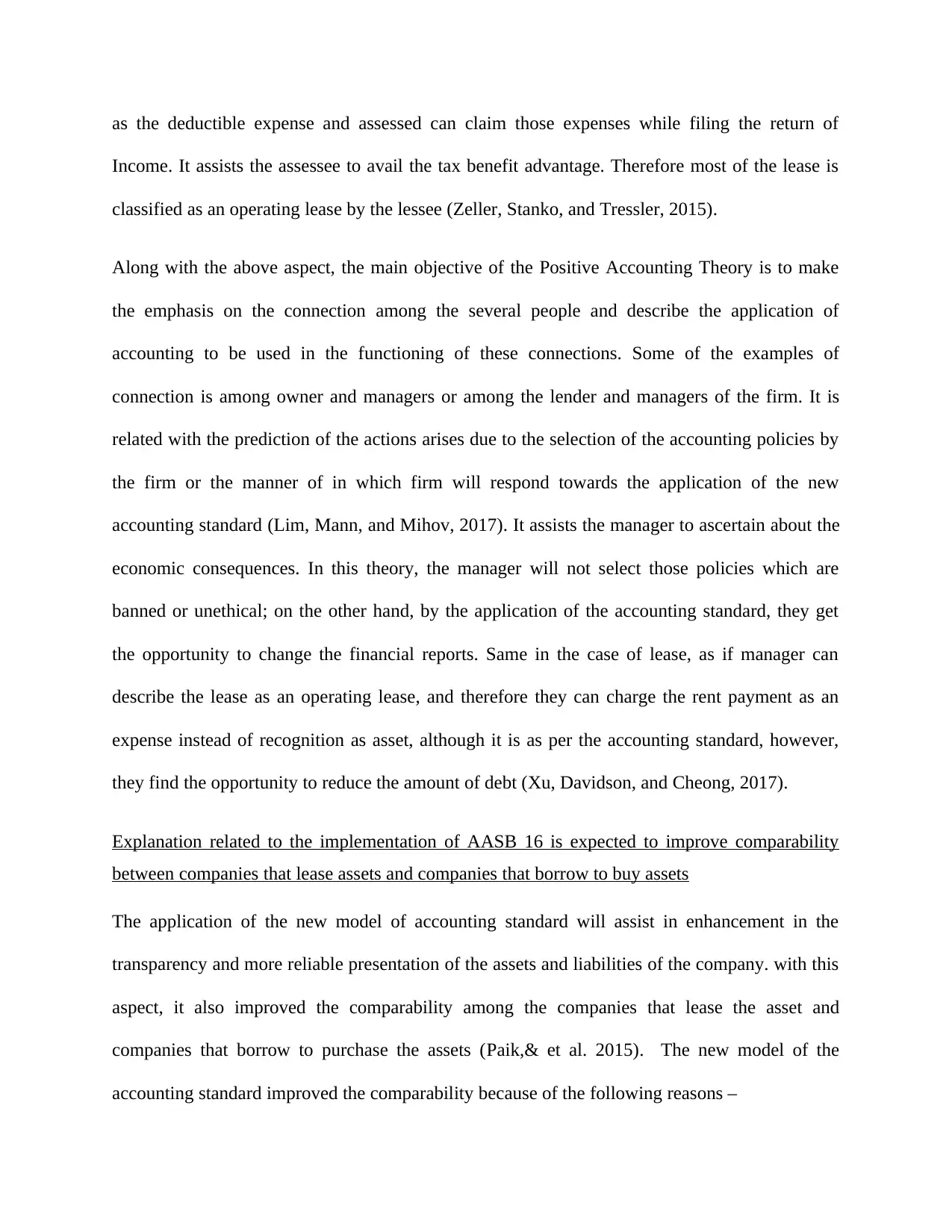
as the deductible expense and assessed can claim those expenses while filing the return of
Income. It assists the assessee to avail the tax benefit advantage. Therefore most of the lease is
classified as an operating lease by the lessee (Zeller, Stanko, and Tressler, 2015).
Along with the above aspect, the main objective of the Positive Accounting Theory is to make
the emphasis on the connection among the several people and describe the application of
accounting to be used in the functioning of these connections. Some of the examples of
connection is among owner and managers or among the lender and managers of the firm. It is
related with the prediction of the actions arises due to the selection of the accounting policies by
the firm or the manner of in which firm will respond towards the application of the new
accounting standard (Lim, Mann, and Mihov, 2017). It assists the manager to ascertain about the
economic consequences. In this theory, the manager will not select those policies which are
banned or unethical; on the other hand, by the application of the accounting standard, they get
the opportunity to change the financial reports. Same in the case of lease, as if manager can
describe the lease as an operating lease, and therefore they can charge the rent payment as an
expense instead of recognition as asset, although it is as per the accounting standard, however,
they find the opportunity to reduce the amount of debt (Xu, Davidson, and Cheong, 2017).
Explanation related to the implementation of AASB 16 is expected to improve comparability
between companies that lease assets and companies that borrow to buy assets
The application of the new model of accounting standard will assist in enhancement in the
transparency and more reliable presentation of the assets and liabilities of the company. with this
aspect, it also improved the comparability among the companies that lease the asset and
companies that borrow to purchase the assets (Paik,& et al. 2015). The new model of the
accounting standard improved the comparability because of the following reasons –
Income. It assists the assessee to avail the tax benefit advantage. Therefore most of the lease is
classified as an operating lease by the lessee (Zeller, Stanko, and Tressler, 2015).
Along with the above aspect, the main objective of the Positive Accounting Theory is to make
the emphasis on the connection among the several people and describe the application of
accounting to be used in the functioning of these connections. Some of the examples of
connection is among owner and managers or among the lender and managers of the firm. It is
related with the prediction of the actions arises due to the selection of the accounting policies by
the firm or the manner of in which firm will respond towards the application of the new
accounting standard (Lim, Mann, and Mihov, 2017). It assists the manager to ascertain about the
economic consequences. In this theory, the manager will not select those policies which are
banned or unethical; on the other hand, by the application of the accounting standard, they get
the opportunity to change the financial reports. Same in the case of lease, as if manager can
describe the lease as an operating lease, and therefore they can charge the rent payment as an
expense instead of recognition as asset, although it is as per the accounting standard, however,
they find the opportunity to reduce the amount of debt (Xu, Davidson, and Cheong, 2017).
Explanation related to the implementation of AASB 16 is expected to improve comparability
between companies that lease assets and companies that borrow to buy assets
The application of the new model of accounting standard will assist in enhancement in the
transparency and more reliable presentation of the assets and liabilities of the company. with this
aspect, it also improved the comparability among the companies that lease the asset and
companies that borrow to purchase the assets (Paik,& et al. 2015). The new model of the
accounting standard improved the comparability because of the following reasons –
⊘ This is a preview!⊘
Do you want full access?
Subscribe today to unlock all pages.

Trusted by 1+ million students worldwide
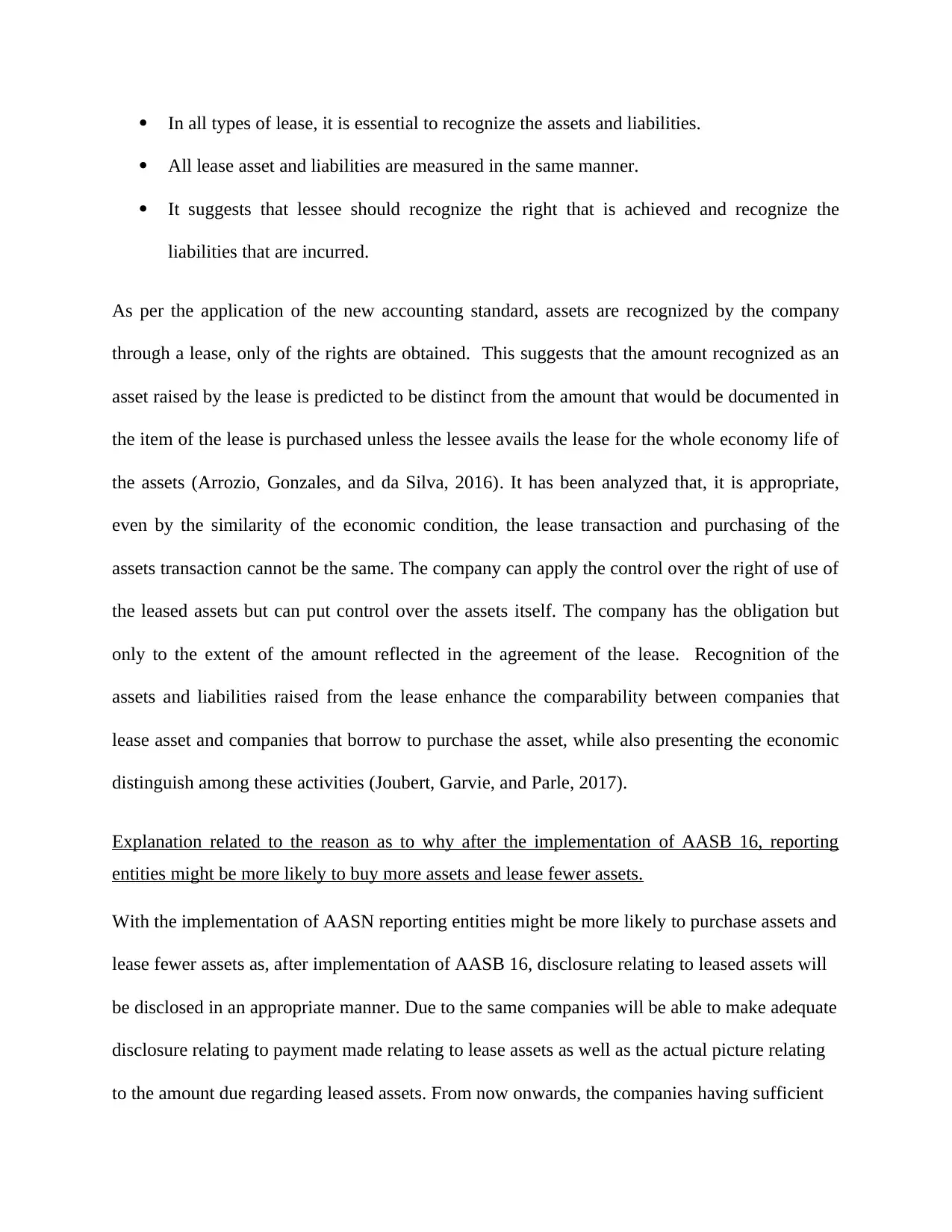
In all types of lease, it is essential to recognize the assets and liabilities.
All lease asset and liabilities are measured in the same manner.
It suggests that lessee should recognize the right that is achieved and recognize the
liabilities that are incurred.
As per the application of the new accounting standard, assets are recognized by the company
through a lease, only of the rights are obtained. This suggests that the amount recognized as an
asset raised by the lease is predicted to be distinct from the amount that would be documented in
the item of the lease is purchased unless the lessee avails the lease for the whole economy life of
the assets (Arrozio, Gonzales, and da Silva, 2016). It has been analyzed that, it is appropriate,
even by the similarity of the economic condition, the lease transaction and purchasing of the
assets transaction cannot be the same. The company can apply the control over the right of use of
the leased assets but can put control over the assets itself. The company has the obligation but
only to the extent of the amount reflected in the agreement of the lease. Recognition of the
assets and liabilities raised from the lease enhance the comparability between companies that
lease asset and companies that borrow to purchase the asset, while also presenting the economic
distinguish among these activities (Joubert, Garvie, and Parle, 2017).
Explanation related to the reason as to why after the implementation of AASB 16, reporting
entities might be more likely to buy more assets and lease fewer assets.
With the implementation of AASN reporting entities might be more likely to purchase assets and
lease fewer assets as, after implementation of AASB 16, disclosure relating to leased assets will
be disclosed in an appropriate manner. Due to the same companies will be able to make adequate
disclosure relating to payment made relating to lease assets as well as the actual picture relating
to the amount due regarding leased assets. From now onwards, the companies having sufficient
All lease asset and liabilities are measured in the same manner.
It suggests that lessee should recognize the right that is achieved and recognize the
liabilities that are incurred.
As per the application of the new accounting standard, assets are recognized by the company
through a lease, only of the rights are obtained. This suggests that the amount recognized as an
asset raised by the lease is predicted to be distinct from the amount that would be documented in
the item of the lease is purchased unless the lessee avails the lease for the whole economy life of
the assets (Arrozio, Gonzales, and da Silva, 2016). It has been analyzed that, it is appropriate,
even by the similarity of the economic condition, the lease transaction and purchasing of the
assets transaction cannot be the same. The company can apply the control over the right of use of
the leased assets but can put control over the assets itself. The company has the obligation but
only to the extent of the amount reflected in the agreement of the lease. Recognition of the
assets and liabilities raised from the lease enhance the comparability between companies that
lease asset and companies that borrow to purchase the asset, while also presenting the economic
distinguish among these activities (Joubert, Garvie, and Parle, 2017).
Explanation related to the reason as to why after the implementation of AASB 16, reporting
entities might be more likely to buy more assets and lease fewer assets.
With the implementation of AASN reporting entities might be more likely to purchase assets and
lease fewer assets as, after implementation of AASB 16, disclosure relating to leased assets will
be disclosed in an appropriate manner. Due to the same companies will be able to make adequate
disclosure relating to payment made relating to lease assets as well as the actual picture relating
to the amount due regarding leased assets. From now onwards, the companies having sufficient
Paraphrase This Document
Need a fresh take? Get an instant paraphrase of this document with our AI Paraphraser
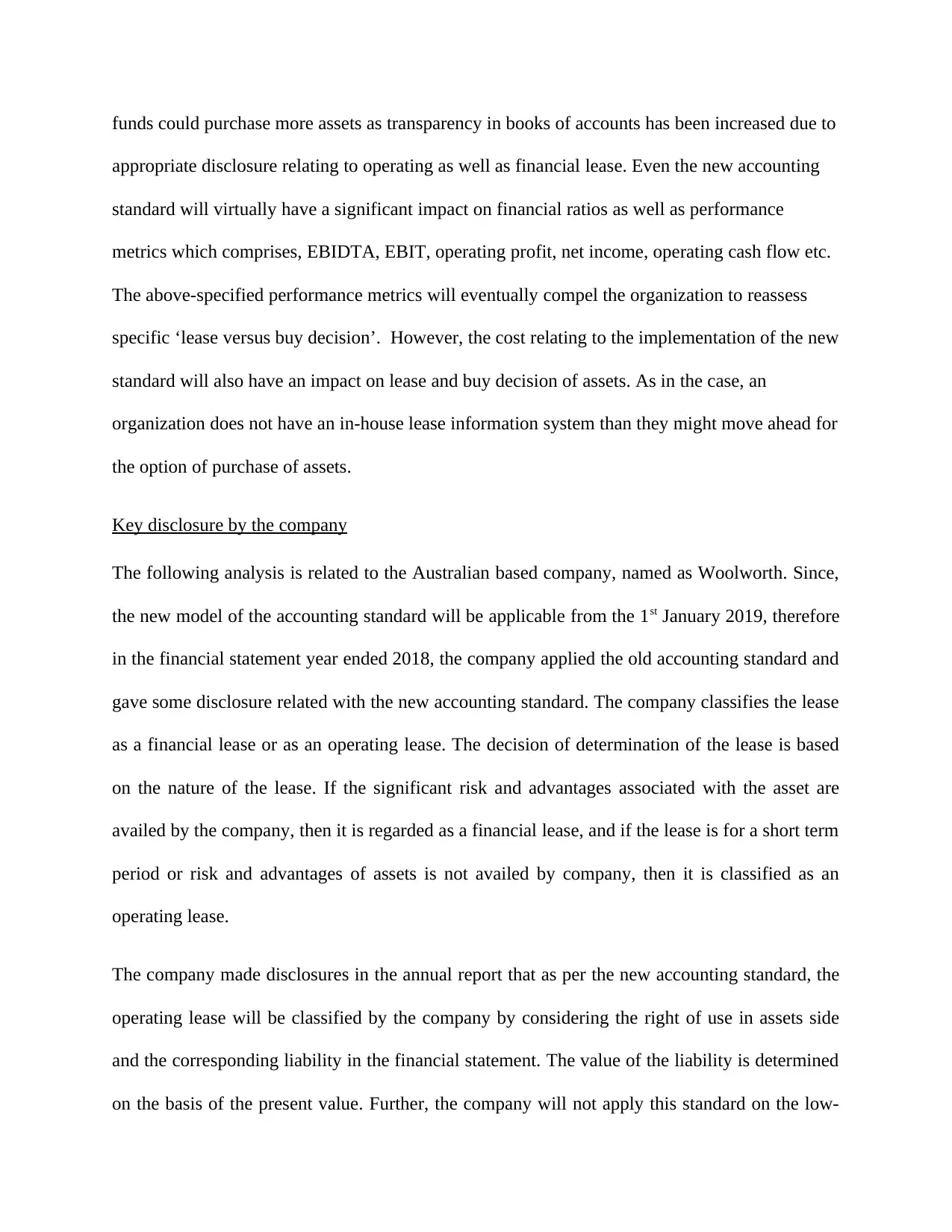
funds could purchase more assets as transparency in books of accounts has been increased due to
appropriate disclosure relating to operating as well as financial lease. Even the new accounting
standard will virtually have a significant impact on financial ratios as well as performance
metrics which comprises, EBIDTA, EBIT, operating profit, net income, operating cash flow etc.
The above-specified performance metrics will eventually compel the organization to reassess
specific ‘lease versus buy decision’. However, the cost relating to the implementation of the new
standard will also have an impact on lease and buy decision of assets. As in the case, an
organization does not have an in-house lease information system than they might move ahead for
the option of purchase of assets.
Key disclosure by the company
The following analysis is related to the Australian based company, named as Woolworth. Since,
the new model of the accounting standard will be applicable from the 1st January 2019, therefore
in the financial statement year ended 2018, the company applied the old accounting standard and
gave some disclosure related with the new accounting standard. The company classifies the lease
as a financial lease or as an operating lease. The decision of determination of the lease is based
on the nature of the lease. If the significant risk and advantages associated with the asset are
availed by the company, then it is regarded as a financial lease, and if the lease is for a short term
period or risk and advantages of assets is not availed by company, then it is classified as an
operating lease.
The company made disclosures in the annual report that as per the new accounting standard, the
operating lease will be classified by the company by considering the right of use in assets side
and the corresponding liability in the financial statement. The value of the liability is determined
on the basis of the present value. Further, the company will not apply this standard on the low-
appropriate disclosure relating to operating as well as financial lease. Even the new accounting
standard will virtually have a significant impact on financial ratios as well as performance
metrics which comprises, EBIDTA, EBIT, operating profit, net income, operating cash flow etc.
The above-specified performance metrics will eventually compel the organization to reassess
specific ‘lease versus buy decision’. However, the cost relating to the implementation of the new
standard will also have an impact on lease and buy decision of assets. As in the case, an
organization does not have an in-house lease information system than they might move ahead for
the option of purchase of assets.
Key disclosure by the company
The following analysis is related to the Australian based company, named as Woolworth. Since,
the new model of the accounting standard will be applicable from the 1st January 2019, therefore
in the financial statement year ended 2018, the company applied the old accounting standard and
gave some disclosure related with the new accounting standard. The company classifies the lease
as a financial lease or as an operating lease. The decision of determination of the lease is based
on the nature of the lease. If the significant risk and advantages associated with the asset are
availed by the company, then it is regarded as a financial lease, and if the lease is for a short term
period or risk and advantages of assets is not availed by company, then it is classified as an
operating lease.
The company made disclosures in the annual report that as per the new accounting standard, the
operating lease will be classified by the company by considering the right of use in assets side
and the corresponding liability in the financial statement. The value of the liability is determined
on the basis of the present value. Further, the company will not apply this standard on the low-
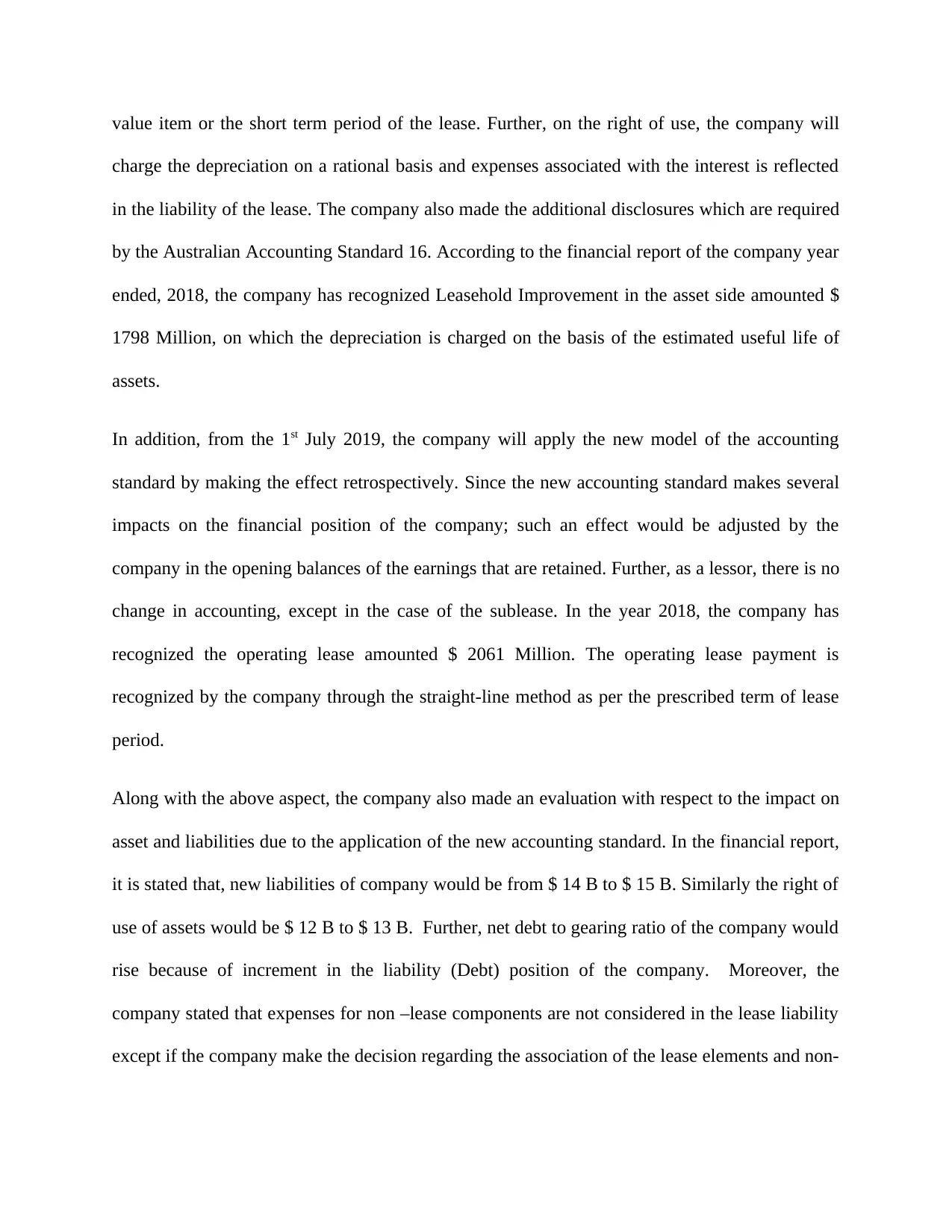
value item or the short term period of the lease. Further, on the right of use, the company will
charge the depreciation on a rational basis and expenses associated with the interest is reflected
in the liability of the lease. The company also made the additional disclosures which are required
by the Australian Accounting Standard 16. According to the financial report of the company year
ended, 2018, the company has recognized Leasehold Improvement in the asset side amounted $
1798 Million, on which the depreciation is charged on the basis of the estimated useful life of
assets.
In addition, from the 1st July 2019, the company will apply the new model of the accounting
standard by making the effect retrospectively. Since the new accounting standard makes several
impacts on the financial position of the company; such an effect would be adjusted by the
company in the opening balances of the earnings that are retained. Further, as a lessor, there is no
change in accounting, except in the case of the sublease. In the year 2018, the company has
recognized the operating lease amounted $ 2061 Million. The operating lease payment is
recognized by the company through the straight-line method as per the prescribed term of lease
period.
Along with the above aspect, the company also made an evaluation with respect to the impact on
asset and liabilities due to the application of the new accounting standard. In the financial report,
it is stated that, new liabilities of company would be from $ 14 B to $ 15 B. Similarly the right of
use of assets would be $ 12 B to $ 13 B. Further, net debt to gearing ratio of the company would
rise because of increment in the liability (Debt) position of the company. Moreover, the
company stated that expenses for non –lease components are not considered in the lease liability
except if the company make the decision regarding the association of the lease elements and non-
charge the depreciation on a rational basis and expenses associated with the interest is reflected
in the liability of the lease. The company also made the additional disclosures which are required
by the Australian Accounting Standard 16. According to the financial report of the company year
ended, 2018, the company has recognized Leasehold Improvement in the asset side amounted $
1798 Million, on which the depreciation is charged on the basis of the estimated useful life of
assets.
In addition, from the 1st July 2019, the company will apply the new model of the accounting
standard by making the effect retrospectively. Since the new accounting standard makes several
impacts on the financial position of the company; such an effect would be adjusted by the
company in the opening balances of the earnings that are retained. Further, as a lessor, there is no
change in accounting, except in the case of the sublease. In the year 2018, the company has
recognized the operating lease amounted $ 2061 Million. The operating lease payment is
recognized by the company through the straight-line method as per the prescribed term of lease
period.
Along with the above aspect, the company also made an evaluation with respect to the impact on
asset and liabilities due to the application of the new accounting standard. In the financial report,
it is stated that, new liabilities of company would be from $ 14 B to $ 15 B. Similarly the right of
use of assets would be $ 12 B to $ 13 B. Further, net debt to gearing ratio of the company would
rise because of increment in the liability (Debt) position of the company. Moreover, the
company stated that expenses for non –lease components are not considered in the lease liability
except if the company make the decision regarding the association of the lease elements and non-
⊘ This is a preview!⊘
Do you want full access?
Subscribe today to unlock all pages.

Trusted by 1+ million students worldwide
1 out of 17
Related Documents
Your All-in-One AI-Powered Toolkit for Academic Success.
+13062052269
info@desklib.com
Available 24*7 on WhatsApp / Email
![[object Object]](/_next/static/media/star-bottom.7253800d.svg)
Unlock your academic potential
Copyright © 2020–2025 A2Z Services. All Rights Reserved. Developed and managed by ZUCOL.




